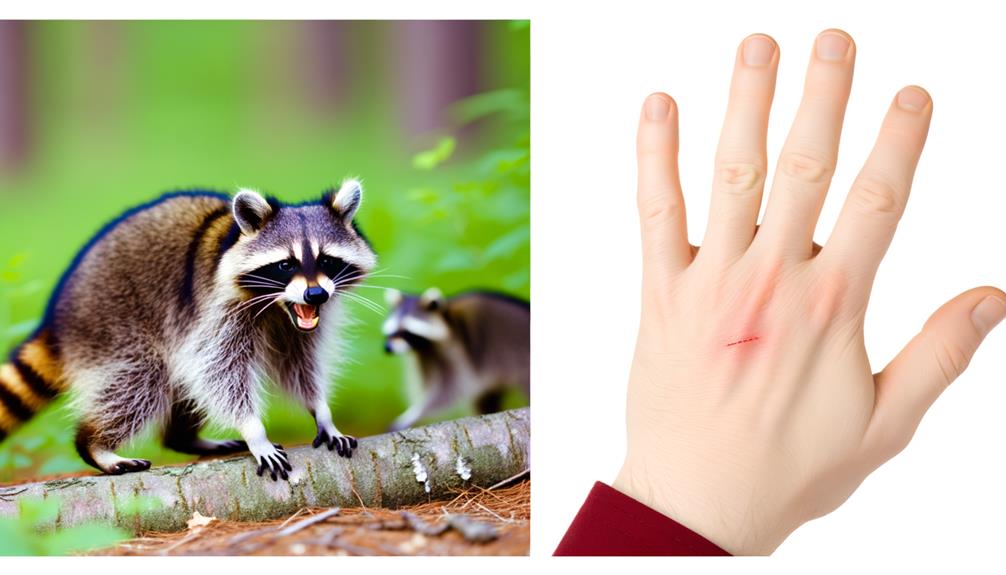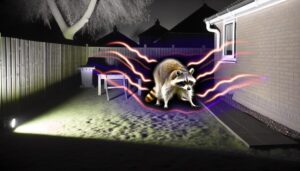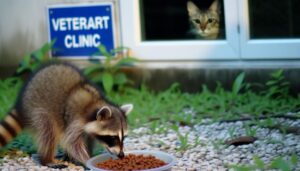How You Get Rabies from a Raccoon Scratch
Yes, rabies can be transmitted via a raccoon scratch if it is contaminated with the animal's saliva. Rabies, a neurotropic virus, spreads through infected saliva entering the body via open wounds or mucous membranes.
Scratches, especially on highly vascular areas, may pose a considerable risk. Immediate wound cleansing and prompt administration of post-exposure prophylaxis (PEP) with rabies immunoglobulin and vaccination are critical to prevent viral encephalitis.
Timely intervention can markedly reduce the risk of severe outcomes. Learn more about the urgency and clinical steps required in such scenarios to safeguard health.

Key Takeaways
- Rabies virus can transmit through scratches contaminated with raccoon saliva.
- Raccoon scratches pose a potential risk for rabies transmission.
- Immediate wound cleansing and post-exposure prophylaxis are crucial.
- Rabies virus can infiltrate through broken skin, leading to encephalitis.
- Timely medical evaluation is vital to prevent rabies after a raccoon scratch.
Understanding Rabies
Rabies is a viral zoonosis that impacts the central nervous system, resulting in acute encephalitis and, if left untreated, is almost invariably fatal. The rabies virus, belonging to the Lyssavirus genus, primarily spreads through the saliva of infected animals, often via bites. Clinical manifestations include prodromal symptoms such as fever, headache, and malaise, followed by neurological signs like agitation, hydrophobia, and paralysis.
The incubation period can vary from weeks to months, influenced by factors such as the site of inoculation and viral load. Diagnosis is typically confirmed post-mortem via direct fluorescent antibody testing of brain tissue, though ante-mortem tests like PCR of saliva or skin biopsies can be indicative. Prompt post-exposure prophylaxis is essential for prevention.
How Rabies Spreads
Transmission of the rabies virus mainly occurs through the introduction of infected saliva into the body via bites, scratches, or open wounds from rabid animals. The rabies virus, a neurotropic virus, travels from the peripheral nerves to the central nervous system, causing fatal encephalitis.
While bites are the most common mode of transmission, scratches contaminated with saliva can also pose a risk. The virus binds to nicotinic acetylcholine receptors at neuromuscular junctions, facilitating its entry and rapid propagation along neural pathways.
Immediate and thorough cleansing of the wound with soap and water can significantly reduce viral load. Post-exposure prophylaxis (PEP), including rabies immunoglobulin and vaccination, is critical for preventing disease progression in exposed individuals.
Risk Factors of Scratches
Scratches inflicted by raccoons pose significant risk factors, primarily concerning bacterial infections and potential rabies virus transmission.
The introduction of pathogenic bacteria through the skin barrier can lead to serious infections, requiring prompt medical intervention.
Additionally, rabies virus transmission through raccoon scratches, though less common than bites, remains a critical public health concern necessitating immediate post-exposure prophylaxis.
Bacterial Infection Concerns
Bacterial infection concerns arise prominently due to the risk factors associated with raccoon scratches, including the introduction of pathogens such as Pasteurella multocida and Capnocytophaga canimorsus into the wound. These bacteria can lead to serious complications, particularly in vulnerable populations such as immunocompromised individuals and the elderly.
The following factors underscore the importance for immediate medical attention:
- Rapid Onset of Symptoms: Infections can manifest within hours to days, presenting with redness, swelling, and pain.
- Systemic Spread: If untreated, bacteria can disseminate, causing severe systemic conditions including sepsis.
- Antibiotic Resistance: Some bacteria may exhibit resistance, complicating treatment protocols and necessitating advanced therapeutic strategies.
Prompt medical intervention is vital to mitigate these infection risks effectively.
Rabies Virus Transmission
In addition to bacterial infection concerns, the potential for rabies virus transmission from raccoon scratches warrants significant attention due to its fatal implications if left untreated.
Rabies virus, a neurotropic pathogen, primarily transmits through saliva via bites; however, scratches contaminated with infected saliva pose a potential risk. The virus can infiltrate through broken skin, traveling to the central nervous system, leading to encephalitis and subsequent death if prophylaxis is not promptly administered.
High-risk factors include scratches in highly vascular areas, delayed wound cleaning, and lack of post-exposure prophylaxis (PEP).
Immediate and thorough wound cleansing, coupled with timely PEP, is imperative to mitigate rabies transmission risk. Healthcare providers must educate on the urgency of medical evaluation following raccoon encounters.
Symptoms to Watch For
Early symptoms of rabies from a raccoon scratch often include fever, headache, and general weakness or discomfort. As the virus progresses, further symptoms may manifest, necessitating prompt medical attention. These symptoms may include:
- Neurological Signs: Anxiety, confusion, and agitation.
- Hydrophobia: Difficulty swallowing and fear of water.
- Paralysis: Progressive muscle paralysis starting from the site of the scratch.
Clinicians must remain vigilant for these signs, as rabies is nearly always fatal once symptoms appear. The incubation period can vary, typically ranging from a few days to several months. Recognizing early clinical manifestations is vital for timely intervention. Health professionals should educate potential at-risk individuals about these symptoms, ensuring they seek immediate care if exposed.
Immediate Steps After a Scratch
Upon sustaining a scratch from a raccoon, immediate and thorough wound cleansing with soap and water is critical to reduce the risk of rabies transmission. Vigorous washing helps remove saliva and potential viral particles. After cleansing, apply an antiseptic solution to further disinfect the area. Cover the wound with a sterile bandage to prevent secondary infections.
| Immediate Action | Clinical Importance | Emotional Impact |
|---|---|---|
| Wash with soap & water | Reduces viral load | Feeling of control |
| Apply antiseptic | Prevents infection | Sense of safety |
| Cover with bandage | Minimizes contamination | Assurance |
| Monitor wound | Detects signs of infection | Peace of mind |
Prompt action is pivotal in mitigating infection risks and ensuring patient well-being.
Seeking Medical Attention
After immediate wound care, it is crucial to seek medical attention to evaluate the need for post-exposure prophylaxis (PEP) against rabies. Healthcare professionals will assess the risk based on several factors:
- Nature of the Scratch: The depth, location, and severity of the scratch influence the likelihood of rabies transmission.
- Raccoon Behavior: Observing whether the raccoon displayed unusual or aggressive behavior, which can be indicative of rabies infection.
- Vaccination Status: Determining if the affected individual has been previously immunized against rabies.
Prompt consultation guarantees accurate risk assessment and timely administration of PEP, if necessary. This inclusive approach mitigates the risk of rabies, a fatal zoonotic disease, thereby safeguarding public health.
Prioritizing medical evaluation underscores the dedication to serving others' well-being.
Conclusion
In summation, while rabies transmission via raccoon scratches is exceedingly rare, it remains a potential zoonotic threat. Vigilant monitoring for prodromal symptoms such as fever, malaise, and localized pain is crucial.
Post-exposure prophylaxis (PEP) should be promptly considered, following appropriate wound care protocols. Consulting a healthcare professional guarantees accurate risk assessment and necessary medical intervention, thereby mitigating the possibility of rabies encephalitis.
Adhering to these guidelines is essential for effective disease prevention and management.






